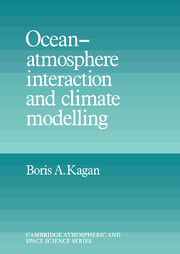Book contents
5 - Large-scale ocean–atmosphere interaction
Published online by Cambridge University Press: 15 January 2010
Summary
Classification of climatic system models
No one doubts that the study of any physical phenomenon should be based on observational data where possible. But let us imagine that there are no such data, or not enough of them. What to do then? Of course, one can always put off the solution of the problem in hand until better times when the volume of empirical information will be sufficient and conclusions following its analysis will obtain credit. But what if we cannot afford the luxury of carrying out costly field measurements, or the time scale of phenomena to be examined is great (say, comparable with the duration of one generation or even the whole of humanity)? Finally, what should we do if the results of the phenomenon that we need to know are not permissible in principle (for example, in the case where there is a problem of clarifying the consequences of a nuclear conflict)? In such situations there is only one answer – to use mathematical models of the phenomena to be investigated.
Mathematical models of the climatic system represent the complex of hydrothermodynamic equations describing the state of separate subsystems complemented by proper initial and boundary conditions and parametrizations for those physical processes which, whether owing to imperfections in our knowledge, or owing to the limitations of available technical and economical means, or both of these, cannot be solved explicitly.
- Type
- Chapter
- Information
- Ocean Atmosphere Interaction and Climate Modeling , pp. 201 - 291Publisher: Cambridge University PressPrint publication year: 1995
- 1
- Cited by

